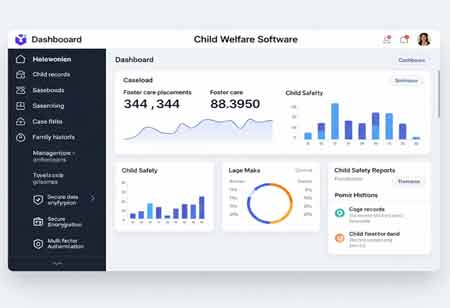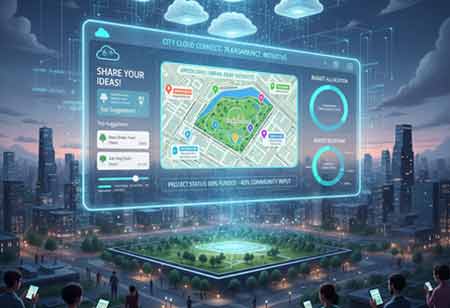THANK YOU FOR SUBSCRIBING
Be first to read the latest tech news, Industry Leader's Insights, and CIO interviews of medium and large enterprises exclusively from Gov CIO Outlook
THANK YOU FOR SUBSCRIBING

By
Government CIO Outlook | Thursday, October 09, 2025
Stay ahead of the industry with exclusive feature stories on the top companies, expert insights and the latest news delivered straight to your inbox. Subscribe today.
The relationship between the citizen and the state is not driven solely by policy, but by a technological undercurrent that has redefined expectations for service delivery across every sector of society. In an era where the private sector offers instantaneous, personalized, and intuitive digital experiences, citizens now expect the same level of service from their public institutions. The engine powering this new era of governance is, unequivocally, the cloud. Moving beyond a mere IT infrastructure choice, cloud computing has become the foundational platform upon which responsive, resilient, and citizen-centric public services are being built.
Today’s citizens navigate their lives through smartphones, expect on-demand access to information, and value seamless, integrated experiences. This conditioning has forged a new, unspoken social contract: public services should be as accessible, reliable, and easy to use as the best consumer applications. The era of long queues, duplicative paperwork, and siloed departmental interactions is fading into obsolescence.
The modern expectation is for a unified, proactive, and personalized relationship with government. Citizens envision a future where renewing a driver's license, registering a business, accessing healthcare records, or paying taxes can be accomplished through a single, secure digital portal, accessible at any time and from anywhere. They expect government agencies to know who they are, understand their needs based on previous interactions and life events, thereby personalizing the services offered. This demand for a consumer-grade experience is the primary catalyst compelling public sector bodies to reimagine their service delivery models from the ground up.
At the most fundamental level, the cloud provides elasticity. Public services often experience fluctuating demand. Consider the surge in traffic on a tax portal during filing season, the massive data processing required for a national census, or the sudden need for a public health information hub during a crisis. In a traditional on-premise model, agencies would have to procure and maintain hardware for peak capacity, leaving vast resources underutilized most of the time. Cloud platforms eliminate this inefficiency. They offer a model of resource elasticity, where computational power, storage, and network bandwidth can be scaled up or down in near real-time. This can be represented by the principle of on-demand allocation, where ResourcesDeployed∝DemandActual. This ensures that services remain performant and available during peak loads while maintaining cost-efficiency during periods of regular activity.
Beyond scalability, the cloud fosters unprecedented agility. Modern cloud-native development, utilizing principles such as microservices and Application Programming Interfaces (APIs), enables agencies to build, deploy, and update services with remarkable speed and agility. Instead of monolithic, slow-to-change systems, services are constructed as a collection of smaller, independent components. This modular approach enables the addition of new features to a mobile application or the reflection of policy changes in a benefits calculator in weeks or days, rather than months or years. APIs act as the connective tissue, enabling different systems and departments to securely share data and functionality, thereby breaking down the information silos that have historically hindered holistic service delivery.
The cloud has fundamentally changed the government's relationship with data. Historically, data was often trapped within specific departments, stored in disparate formats, and challenging to aggregate for meaningful analysis. Cloud-based data platforms offer a unified environment for ingesting, storing, and processing vast quantities of information.
This centralization creates the opportunity to move beyond simple record-keeping towards data-driven governance. By applying advanced analytics, machine learning, and artificial intelligence tools available on major cloud platforms, agencies can transform raw data into actionable intelligence.
This capability allows for evidence-based policymaking, where real-time trends and predictive models inform decisions. Operationally, it enables the optimization of public resources, from managing traffic flow in smart cities to predicting maintenance needs for public infrastructure. For the citizen, it powers the delivery of proactive and predictive services. A system can, for example, automatically notify a family of their eligibility for a new childcare benefit upon registration of a birth, or alert a small business owner about a new grant they qualify for based on their industry and location.
The ultimate trajectory of this evolution is the concept of "Government-as-a-Platform" (GaaP). In this model, the government provides the core, secure digital infrastructure—digital identity, secure payment gateways, and data-sharing APIs—upon which a rich ecosystem of public services can be built. This platform approach fosters innovation and enables the rapid development of new citizen-facing solutions.
The citizen experience in a GaaP model is one of complete coherence. An individual interacts with a single digital identity that serves as their passport to all government services. This unified portal offers a personalized dashboard that displays relevant information and pending tasks, including upcoming vehicle inspections and voting registration deadlines. The experience is omnichannel, seamlessly moving between a web browser, a mobile app, and an intelligent chatbot, with the interaction context maintained across all channels.
This forward-looking model is not a distant vision but the logical continuation of the current digital transformation. By leveraging the immense power of cloud computing, public institutions are progressively dismantling the barriers of the past. They are building services that are not only more efficient for the government, but more importantly, are more respectful of citizens’ time and needs. The journey is one of continuous iteration and improvement, moving public administration from a provider of static services to an orchestrator of intelligent and deeply human-centric outcomes. The cloud era is providing the tools not just to digitize government, but to reinvent it for a new generation.
I agree We use cookies on this website to enhance your user experience. By clicking any link on this page you are giving your consent for us to set cookies. More info



